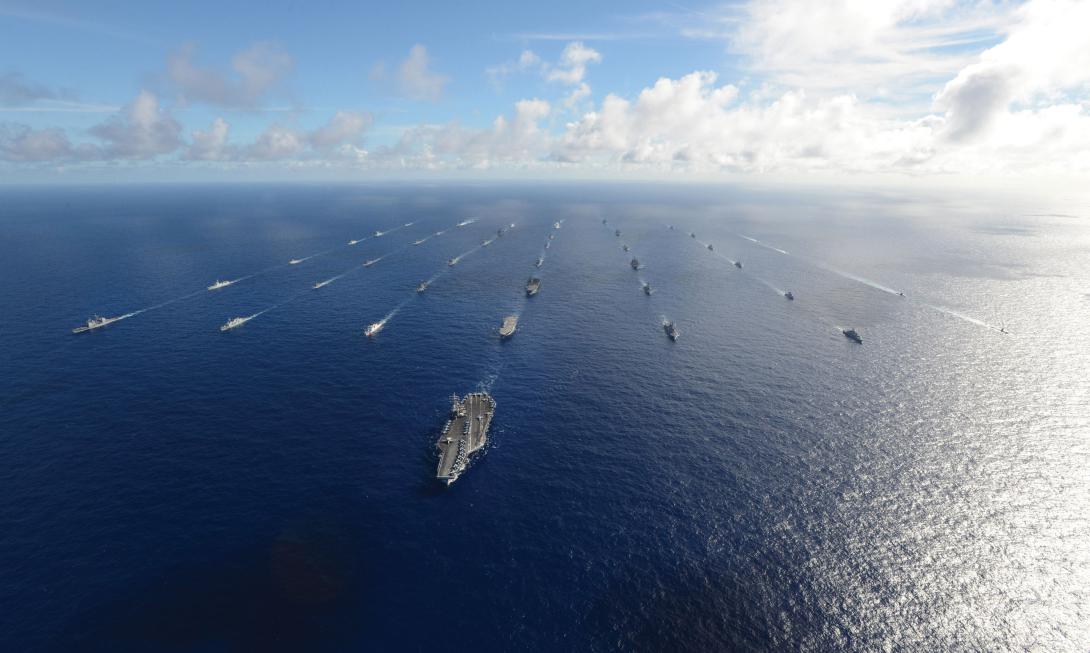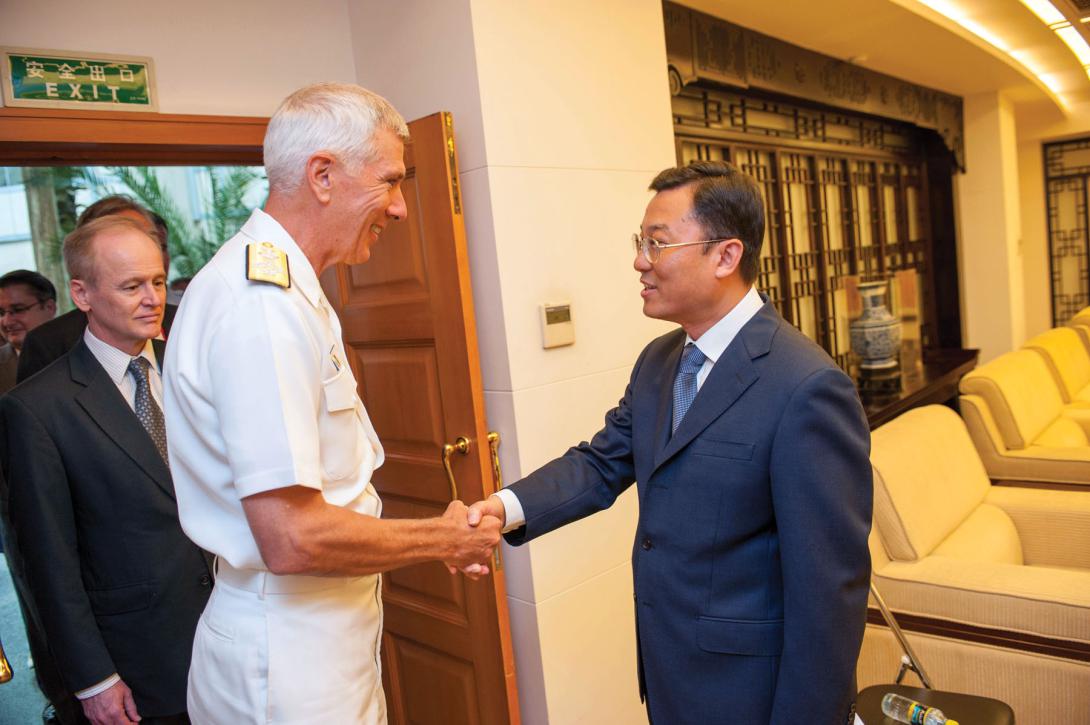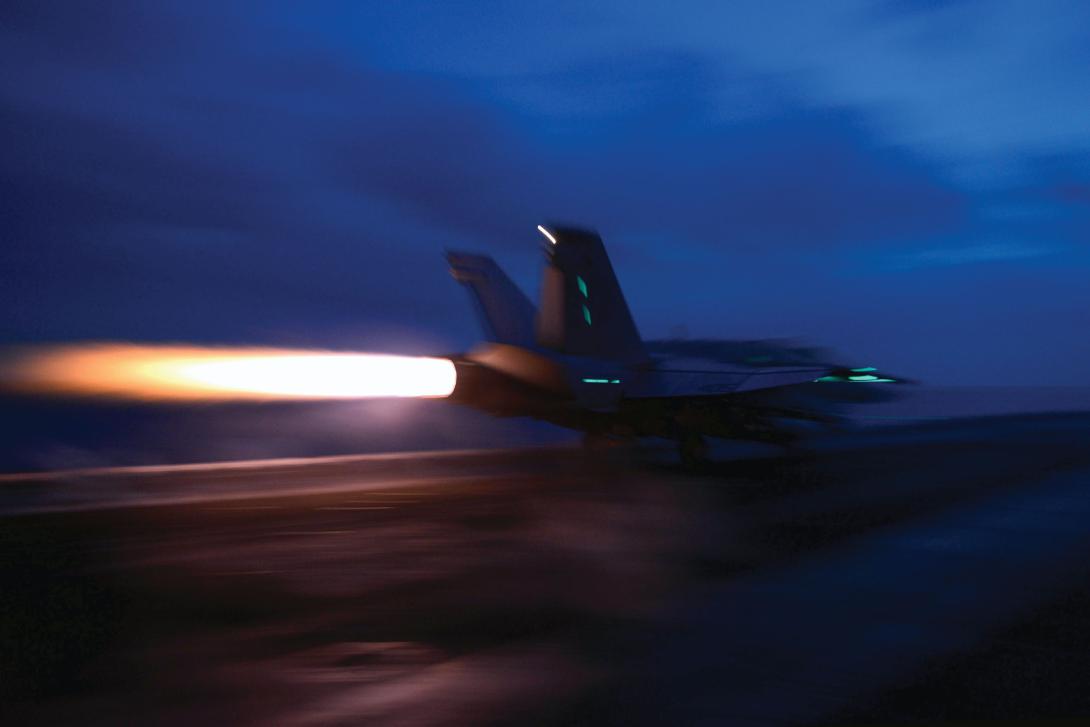Recent Events Test Pacific Command Agenda
The U.S. strategic rebalance toward the Asia-Pacific region is being challenged by internal and external developments that are changing how the U.S. Pacific Command carries out its missions. Internal developments include budgetary pressures and local disputes. External developments include terrorism that could be migrating into the vast region.
The budget cuts that have affected every element of the U.S. military are threatening Pacific Command (PACOM) force readiness severely. Many nations in the area have territorial disputes with their neighbors that could flare up into open conflict merely as a result of a miscalculation or misunderstanding. And, global security events elsewhere are jeopardizing the implementation of the strategic rebalance.
Adm. Samuel J. Locklear III, USN, is the commander of PACOM. He notes the command works with 35 nations, and it is the United States on which others rely to serve as an honest broker for regional peace and security. Yet the changing threat picture, along with internal challenges that continue to alter the geostrategic landscape, are muddying an already-unclear image of the future.
In recent weeks, the Islamic State in Iraq and the Levant (ISIL) has taken more of the command’s attention. Adm. Locklear allows that PACOM has spent more time with its allies and partners examining ISIL’s implications on the Asia-Pacific region. One focus area is the potential spread of the group’s ideology into the region, but another concern is that ISIL’s foreign fighters might return to the region and sow their brand of terrorism throughout the area. “This has been on everybody’s mind over the past few weeks,” he says.
The other issue in recent weeks that has dominated attention is North Korea. Its unstable regime remains PACOM’s top concern, Adm. Locklear posits. The rogue state refuses to abide by U.N. requirements, opting instead to continue to pursue the development of nuclear weapons and missile delivery systems that could threaten both the region and the U.S. homeland. North Korea has transitioned from a conventional military focus to one that is more asymmetric and far-reaching.
Adm. Locklear decries any notion that North Korea might respect U.N. directives better if the U.N. Command that has opposed it since it invaded South Korea in 1950 were dissolved. It is in the best interest of the U.N. to keep the command in place in its existing form, the admiral says. In the long run, the U.N. will continue to have a significant interest in the outcome of either a reunified peninsula or a regime that continues to misbehave. “It’s better for us to keep [the U.N. Command] in place as it is, and maybe even make it stronger in some areas,” he declares.
One key to preventing North Korea from erupting violently is to know as much as possible about what is taking place inside the closed country, the admiral offers. This will require continued assessment of the U.S. ability to understand what the regime is up to and how much control it is under. Working closely with South Korea will help in that endeavor, and China can help shape the outcome of the Korean peninsula. “China has the ability to help us shape [North Korean actions] so that we maintain peace and prosperity on the Korean peninsula—and move North Korea toward something other than a failed state,” Adm. Locklear says.
North Korea is the most dangerous threat to the global security environment, the admiral declares. But, other threats offer the potential for upsetting the peace and security of the Asia-Pacific region. He cites tensions over territorial disputes as a potential conflict area if they are not managed carefully and dealt with thoughtfully. Nontraditional threats from terrorism could move into the region from elsewhere. And, natural disasters that tax the resources of nations likely will increase in effect as the area’s population continues to grow. Adm. Locklear relates that he tells his staff that the chances of fighting a major conflict in the region are fairly remote, but the chance of having to deal with a large humanitarian disaster relief mission is virtually ensured.
The U.S. strategic rebalancing toward the Asia-Pacific region continues, and most experts agree with its rationale, Adm. Locklear says. However, whether this rebalancing is sustainable is under debate. The arguing points against sustainability largely focus on geopolitical events such as the rising ISIL threat and Russian activities in Crimea and Ukraine. The challenge is whether these new issues will distract the United States from being able to execute the military aspect of the rebalance to the Asia-Pacific region, the admiral observes.
Budgetary pressures are affecting all aspects of military operations for planners and decision makers, and PACOM is no exception. Adm. Locklear describes the budgetary uncertainty of the past two years, particularly the Budget Control Act sequestration and the lack of a fixed budget around which services can plan, as “a business model that we wouldn’t want to continue to repeat.” Its key flaws are its inefficiency as well as its inability to allow the military to move the joint force into the future, he emphasizes. Also, continuing resolutions generate spending patterns based on previous plans, which inhibits innovation.
A more serious effect occurs if Congress makes budget decisions late in the year, the admiral offers. That leaves the services with only limited places where they can make cuts to meet targets in a short period of time. The result is the military must enforce spending reductions in operational and readiness accounts. “We see the force that we have to use, in some cases, is less ready and less accessible,” Adm. Locklear declares. “That does impact us here.”
Readiness is a key variable in flexibility, the admiral professes. A more ready force enables more flexible options when it becomes necessary to deal with crises or build partnership capacity. A decline in readiness leads to a reduction in flexibility.
This does not mean the numbers and capabilities of PACOM ships and aircraft are declining, he says. “What it means is the ones we have generally are less usable or are usable less amount of time. This forces us to make choices.”
The command has been able to manage those choices in a way that allows the services to adjust to “the physical realities they are facing,” he says. He adds that PACOM has sought efficiencies over the past couple of years.
Over time, the military will have a smaller and more agile force—“hopefully, more lethal,” the admiral continues. “We’ve gone through this before; we’ve gone through downsizes where we had to reshape the military. I give us high marks for being able to do that.
“But to do that requires budget stability—and right now we don’t have that,” he observes.
PACOM has moved forward with its allies in the region to ensure that their alliances “are properly articulated for the 21st century and not the past century,” Adm. Locklear relates. The command also has made substantial progress ensuring that the force posture and the laydown of forces west of the international date line is supportive of the evolving security architecture. PACOM has expanded its information sharing among allies and partners alike, particularly for maritime domain awareness. The command has expanded multilateral support with the Association of Southeast Asian Nations (ASEAN). And, pursuant to concerns with ISIL, the command is working closer with allies and partners on the flow of terrorism into and throughout the region, the admiral says.
Several countries dominate the menu of change in the Asia-Pacific region. The U.S. relationship with China is one of the defining factors in that region, and PACOM strives to work with China’s military leadership. The People’s Liberation Army (PLA) does not have any equivalent organization with PACOM, as the entire Chinese military is designed around the defense of its nation versus regional commands around the globe. So, aligning with the PLA on larger issues is more difficult, the admiral offers.
The two countries continue to exchange visits with highest-ranking military officers, and these exchanges provide opportunities for dialogue, Adm. Locklear says. These relationships tend to take form at the service-to-service level, and they have improved over the past couple of years. Most of this communication is formatted and timed. The two countries have hotline capabilities at the regional command level, the Joint Chiefs chairman level and the defense secretary level that they exercise periodically, he offers. On a tactical level, the PLA and PACOM communicate with each other when they are in local operations together.
Adm. Locklear states that PACOM has sought opportunities for the PLA to be able to exhibit transparency. The United States and its allies and partners are concerned that PLA growth and its direction are not transparent enough to be understood by the rest of the Asia-Pacific community. “We continue to encourage them to become more transparent, and I think they generally agree with that, but finding the opportunities for them to do that is important.”
A major step in that direction took place this past summer with the first PLA participation in the Rim of the Pacific (RIMPAC) exercise. China sent “a very credible force” to join the other 21 RIMPAC 2014 nations, many of which do not trust China. The PLA did show transparency “with multiple countries,” the admiral reports.
“We want to look well beyond just that particular exercise and say ‘What are those things that allow us to do that?’ But we also have to be pragmatic,” he continues. The two Pacific powers have several areas where they do not agree, particularly in China’s cyber activity, but PACOM and the U.S. government will continue to try to maintain balance in the relationship, the admiral says. Continued dialogue may lesson future friction points.
PACOM has “significantly improved” its military-to-military relationship with India, Adm. Locklear declares. The United States has had good military relationships with India over the past couple of decades, he notes, and both countries have made steady strides in continuing to find opportunities to exercise and work together, particularly in the maritime and land domains.
One of the biggest changes between the two countries has been in the ability to share and to conduct defense trade, the admiral continues. The United States is now the top foreign military sales vendor to India, having passed Russia in that distinction. Arms sales alone do not quantify global security, but they do establish a positive relationship that can benefit the long-term security environment.
“India is a major power, and it will play a significant role in the security environment,” Adm. Locklear states. “Having systems that we either sell each other or produce together ties [the countries] together as militaries in a way that people sometimes don’t recognize.” This especially is true with long-term platforms, such as aircraft, in which personnel from both nations train together. “We’re making progress in that area with our Indian partners, and we hope to make more,” the admiral says.
A key focus on growing that partnership will be the defense trade initiatives. Both countries also will build on ongoing exercises. Adm. Locklear allows that India is taking a greater look toward the east instead of its traditional westward focus, particularly in terms of economic growth through trade. The ability of the United States to work with India both bilaterally and multilaterally “will continue to be important to the security environment,” he emphasizes.
India’s defense outreach extends beyond the United States. Adm. Locklear says India is building an improving relationship with Japan, especially because Japan is a close ally of the United States and the U.S.-India strategic relationship is growing. This presents a potential natural synergy among the three nations for many issues, he observes.
Many nations in the region, especially those in Southeast Asia, increasingly recognize the importance of U.S. oversight for the security picture in the Asia-Pacific region, Adm. Locklear points out. “There is a growing recognition that it’s important to their peace and prosperity, that there’s really nothing they should fear from the United States. We’ve been there doing this with them for about 70 years, and most everybody—including China—has benefitted by the fact that the U.S. government has provided stability for the region,” he explains.
The United States continues to expand its relationships with other countries in the region. “We have a much more robust dialogue today with Malaysia, and that has been very fruitful for the region as well as for us,” the admiral says. “We have a growing dialogue with Vietnam about our shared interests. And that’s just to name a few.”







Comments